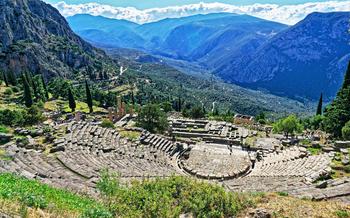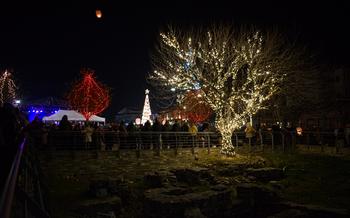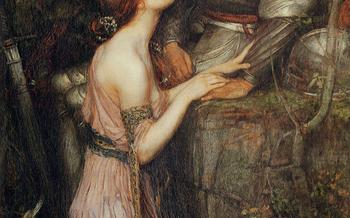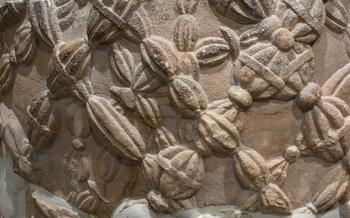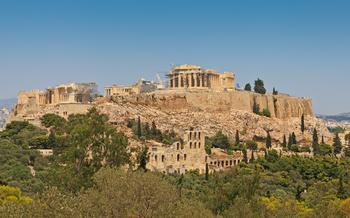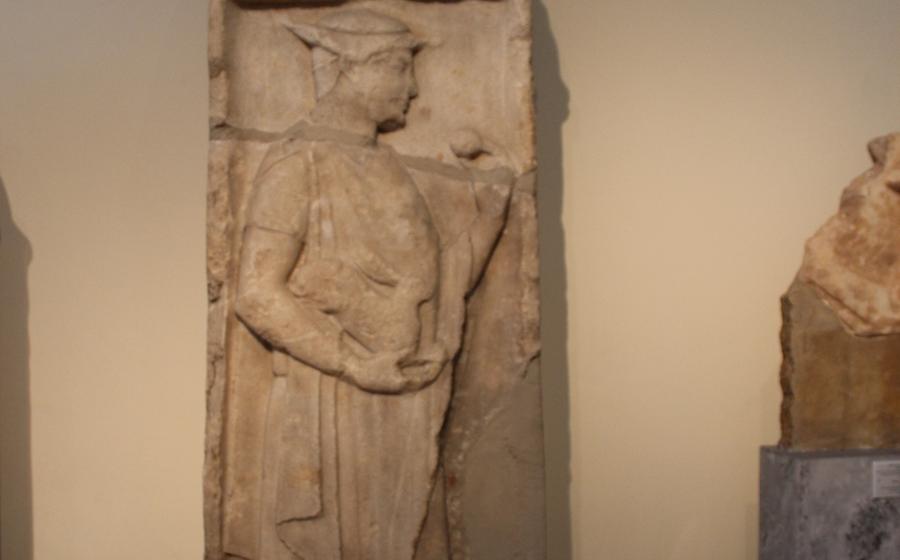
Archaeological Museum of Larissa
- Larissa Archaeological Museum: A Journey Through History
- Unveiling the Past: The Museum's Exhibits
- A Stroll Through Time: Museum Highlights
- Exploring the History of Larissa: A Timeline
- The Lion of Larissa: A Symbol of Strength
- Ancient Pottery: A Canvas of History
- Sculptures and Mosaics: Artistic Masterpieces
- Coins of Larissa: A Glimpse into the Economy
- Interactive Exhibits: Engaging with the Past
- Guided Tours: Unveiling Hidden Treasures
- Museum Shop: Souvenirs and Treasures
- Accessibility for All: Ensuring Inclusivity
- Planning Your Visit: Essential Information
- Beyond the Museum: Exploring Larissa
- Insider Tip: Discovering Hidden Gems
Larissa Archaeological Museum: A Journey Through History
The Archaeological Museum of Larissa, nestled in the heart of the city, stands as a testament to the rich and storied past of this ancient Greek city. Step inside, and you will be transported on a journey through time, from the Neolithic era to the Ottoman Empire and beyond, as you explore the museum's diverse collection of artifacts. The museum houses a wealth of treasures, including prehistoric tools, ancient Greek pottery, exquisite sculptures, and a remarkable numismatic collection. Guided tours are available to enhance your experience, providing insights into the historical significance and cultural context of these remarkable artifacts. The museum is fully accessible, ensuring that all visitors can embark on this journey through the annals of Larissa's past.
Unveiling the Past: The Museum's Exhibits
The Archaeological Museum of Larissa houses an impressive collection of artifacts that span various periods of the city's rich history. Among the highlights are:
-
Prehistoric artifacts: These include pottery, tools, and weapons from the Neolithic and Bronze Age periods, providing a glimpse into the earliest settlements in the region.
-
Ancient Greek pottery: The museum displays a vast collection of pottery from different periods, including Geometric, Archaic, Classical, and Hellenistic. These vessels exhibit a variety of shapes, sizes, and decorations, reflecting the artistic and technical skills of ancient Greek potters.
-
Sculptures and mosaics: The museum boasts a collection of marble and bronze sculptures, depicting gods, heroes, and everyday life. These works of art offer insights into the artistic styles and iconography of ancient Greece. The museum also houses a collection of mosaic floors and wall decorations, showcasing the intricate craftsmanship of ancient artisans.
-
Numismatic collection: The museum's coin collection includes coins from different periods of Larissa's history, providing valuable insights into the city's economy and trade relations. The coins feature a variety of symbols and inscriptions, shedding light on the political and religious aspects of ancient Larissa.
A Stroll Through Time: Museum Highlights
At the Archaeological Museum of Larissa, remarkable artifacts await visitors, each telling a unique tale of the region's rich past. Among these treasures, four stand out as exceptional highlights:
-
The Lion of Larissa: This majestic bronze sculpture, dating back to the 4th century BC, depicts a powerful lion standing guard. Discovered in the ancient city of Larissa, it symbolizes strength, courage, and the city's proud heritage.
-
The Bronze Statuette of Zeus: This exquisite statuette, crafted in the 5th century BC, portrays the mighty god Zeus, the king of the Olympian gods. With intricate details and a commanding presence, it offers a glimpse into the religious beliefs and artistic prowess of ancient Greece.
-
The Votive Relief of Asclepius: This marble relief from the 4th century BC depicts the Greek god of healing, Asclepius. Found in the Asclepieion, a sanctuary dedicated to the god, it showcases the importance of medicine and healing in ancient Greek society.
-
The Gold Diadem of Larissa: This stunning gold diadem, dating back to the 3rd century BC, is a testament to the region's exquisite craftsmanship. Featuring intricate filigree work and delicate motifs, it represents the artistry and opulence of ancient Greek jewelry.
Exploring the History of Larissa: A Timeline
Larissa's rich history spans millennia, leaving behind a tapestry of civilizations and cultures that have shaped its identity. From its humble beginnings to its modern incarnation as a vibrant city, let's journey through the annals of time to uncover the layers of Larissa's past.
Neolithic Origins
The earliest traces of human habitation in Larissa date back to the Neolithic period, around 6000 BC. Excavations have revealed evidence of a thriving agricultural community that laid the foundation for the city's future development.
Ancient Greek City-State
In the 8th century BC, Larissa emerged as a prominent city-state in ancient Greece. As part of the powerful Thessalian League, it played a significant role in regional politics and military conflicts. The city's strategic location on the fertile plains of Thessaly made it a prosperous trading hub and a center of cultural and intellectual activity.
Roman and Byzantine Rule
In the 2nd century BC, Larissa fell under Roman rule. The city continued to flourish under Roman administration, benefiting from the construction of new infrastructure and the introduction of Roman customs and laws. After the division of the Roman Empire, Larissa became part of the Byzantine Empire, retaining its status as a major administrative and cultural center.
Ottoman Empire and Modern Greece
In the 15th century, Larissa was conquered by the Ottoman Empire. For nearly five centuries, the city remained under Ottoman rule, experiencing both periods of prosperity and decline. In 1881, Larissa was liberated and became part of the newly established Kingdom of Greece. The city underwent rapid modernization and expansion, emerging as a significant industrial and commercial center in the region.
The Lion of Larissa: A Symbol of Strength
In the heart of the Archaeological Museum of Larissa, a majestic bronze statue known as the Lion of Larissa stands as a testament to the city's rich history and enduring legacy. Discovered in 1860 during excavations near the ancient citadel, this awe-inspiring sculpture has become an iconic symbol of Larissa, embodying the strength, courage, and resilience of its people.
Dating back to the 4th century BC, the Lion of Larissa is a masterpiece of ancient Greek craftsmanship. Standing approximately 2 meters tall, the lion is depicted in a powerful and commanding stance, its muscular body poised to strike. The intricate details of its mane, fur, and facial features reflect the exceptional skill and artistry of its creator.
The Lion of Larissa is believed to have served as a votive offering to Zeus, the king of the gods, or to Apollo, the patron deity of Larissa. Its discovery within the precincts of the ancient sanctuary dedicated to Apollo further supports this theory. The presence of the lion in such a sacred context suggests that it was held in high regard by the people of Larissa and may have been associated with their hopes for protection, victory, and prosperity.
Intriguingly, the Lion of Larissa has become the subject of numerous myths and legends, adding to its mystique. One tale speaks of a fierce lion that once terrorized the region, and how the gods sent a hero to slay the beast, thus saving the people from its wrath. Another legend suggests that the lion was a guardian of the city, symbolizing its strength and invincibility.
To honor the significance of this remarkable artifact, a replica of the Lion of Larissa has been erected in the city center, serving as a reminder of the city's glorious past and its enduring spirit. This replica stands as a testament to the enduring legacy of the original sculpture, which continues to captivate and inspire visitors from around the world.
Ancient Pottery: A Canvas of History
At the Archaeological Museum of Larissa, ancient pottery takes center stage, showcasing the creativity and craftsmanship of past civilizations. These remarkable artifacts provide a glimpse into the daily lives and artistic expressions of the people who once called Larissa home.
Pottery production in Larissa dates back to the Neolithic period, and the museum's collection features a wide range of styles and techniques that evolved over time. From the simple, utilitarian vessels of the early farmers to the intricately decorated masterpieces of the Classical era, each piece tells a story of artistic innovation and cultural exchange.
Visitors can admire the geometric patterns and stylized figures characteristic of the Geometric period, the narrative scenes and mythological imagery of the Archaic period, and the refined forms and naturalistic depictions of the Classical period. These vases, plates, and amphorae were not merely functional objects; they were also canvases for storytelling, religious expression, and artistic experimentation.
The museum's collection includes both locally produced pottery and imported goods from other regions of Greece and beyond. This reflects Larissa's role as a major trading center in antiquity, where goods and ideas flowed from one corner of the Mediterranean to another.
Whether it's a humble cooking pot or an exquisitely painted krater, each piece of pottery in the Archaeological Museum of Larissa offers a unique glimpse into the lives, beliefs, and artistic traditions of ancient Greece.
Sculptures and Mosaics: Artistic Masterpieces
The Archaeological Museum of Larissa houses a remarkable collection of sculptures and mosaics, showcasing the artistic prowess of ancient Greek and Roman craftsmen. These works of art provide a glimpse into the religious beliefs, cultural values, and everyday life of Larissa's inhabitants.
Marble and bronze sculptures, meticulously carved and cast, depict gods, heroes, and ordinary individuals with intricate detail. The expressions, gestures, and poses of these figures convey a sense of realism and emotion, capturing the essence of ancient Greek culture.
The museum's mosaic collection is equally impressive, featuring intricate designs and vibrant colors. These mosaics once adorned the floors and walls of wealthy homes and public buildings, adding a touch of luxury and elegance to the ancient city.
Highlights include a mosaic depicting a scene from the Trojan War, with warriors engaged in battle against a backdrop of intricate geometric patterns. Another mosaic features a charming depiction of everyday life, showing children playing and adults engaged in various activities.
These sculptures and mosaics offer a unique perspective on the artistic traditions of ancient Larissa. They reflect the city's cultural exchange with other regions of Greece and the wider Mediterranean world.
Coins of Larissa: A Glimpse into the Economy
Delving into the Numismatic Collection
The numismatic collection at the Archaeological Museum of Larissa offers a fascinating glimpse into the economy of ancient Larissa. Coins, used as currency in ancient Greece, provide valuable insights into the city's trade and commerce.
Coinage History and Types
Larissa began minting its own coins in the 5th century BC, during the Classical period. These early coins were made of silver and featured the city's symbol, the horse. As Larissa grew in importance and wealth, it began to mint gold coins as well.
The museum's collection includes a variety of coins from different periods of Larissa's history. Visitors can see coins from the Classical, Hellenistic, and Roman periods, each with its own unique designs and inscriptions.
Symbols and Inscriptions
The coins of Larissa often feature symbols and inscriptions that provide information about the city and its history. The horse, as mentioned earlier, was a common symbol on Larissa's coins. Other symbols include the head of the goddess Athena, the god Zeus, and the hero Heracles.
The inscriptions on the coins often include the name of the city, the magistrate who issued the coin, and the year of issue. These inscriptions are valuable for dating the coins and for understanding the political and economic history of Larissa.
Economic Significance
The coins of Larissa were used for a variety of purposes, including trade, taxation, and religious offerings. Trade was particularly important for Larissa, which was located on a major trade route between Greece and the Black Sea. The city's coins were accepted throughout the ancient world, indicating its economic power and influence.
Trade and Commerce in Ancient Larissa
The numismatic collection at the Archaeological Museum of Larissa provides a glimpse into the vibrant trade and commerce that took place in the city in ancient times. The coins offer a tangible connection to the people of Larissa and their daily lives.
Interactive Exhibits: Engaging with the Past
At the Archaeological Museum of Larissa, visitors can immerse themselves in the history and culture of the region through interactive exhibits that bring the past to life. Multimedia presentations showcase the museum's artifacts and provide in-depth information on various historical topics. Visitors can explore hands-on activities that allow them to learn about ancient techniques and crafts. The museum also offers educational programs, workshops, and lectures that delve deeper into the history and archaeology of Larissa. These interactive experiences make the museum a vibrant and engaging destination for visitors of all ages, creating a lasting connection with the past.
Guided Tours: Unveiling Hidden Treasures
Expert Insights and Historical Context
Delve deeper into the captivating stories behind the artifacts with guided tours led by knowledgeable experts. These experienced guides provide insightful commentary and historical context, bringing the ancient world to life. Embark on a journey through time as you explore the museum's galleries, uncovering the secrets of Larissa's rich history and cultural heritage.
Thematic Tours for Specific Interests
To cater to diverse interests, the Archaeological Museum of Larissa offers themed tours that focus on specific aspects of its collection. Whether you're fascinated by ancient pottery, sculptures, or numismatics, there's a tour designed to satisfy your curiosity. These specialized tours delve into the intricacies of each subject, providing a deeper understanding and appreciation for the museum's treasures.
Booking Information and Availability
To ensure a spot on a guided tour, advance booking is recommended, especially during peak tourist season. Check the museum's website or contact the information desk for tour schedules and availability. Guided tours are typically offered in multiple languages to accommodate international visitors.
Tips for Getting the Most Out of a Tour
To make the most of your guided tour experience, arrive a few minutes early to avoid any delays. Be sure to wear comfortable shoes, as you'll be doing a fair amount of walking. Take advantage of the opportunity to ask questions and engage with your guide. Don't forget your camera to capture the stunning artifacts and exhibits you'll encounter along the way.
Museum Shop: Souvenirs and Treasures
The Archaeological Museum of Larissa houses a well-stocked museum shop where visitors can purchase a variety of souvenirs and treasures to remember their visit. The shop offers a wide range of items, including books and publications on the history and archaeology of Larissa, replica artifacts such as pottery and jewelry, and local crafts and souvenirs.
By purchasing items from the museum shop, visitors not only take home a piece of Larissa's rich history but also support the museum and its ongoing initiatives. The revenue generated from the shop helps fund educational programs, conservation projects, and new acquisitions for the museum's collection.
Some of the popular items available in the museum shop include replicas of the Lion of Larissa, gold diadem, and other iconic artifacts from the museum's collection. Visitors can also find books and postcards featuring images of the museum's exhibits, as well as locally produced crafts such as pottery, textiles, and jewelry.
Whether you are looking for a unique souvenir to remember your trip to Larissa or a thoughtful gift for a friend or family member, the museum shop is sure to have something to suit your needs.
Accessibility for All: Ensuring Inclusivity
The Archaeological Museum of Larissa takes pride in ensuring accessibility and inclusivity for all visitors. Wheelchair users can easily navigate the museum's galleries and exhibits, thanks to ramps and elevators. Braille signage and audio guides are available to assist visually impaired visitors in exploring the museum's treasures. Educational programs are tailored to accommodate differently-abled visitors, providing them with an enriching and engaging museum experience. The museum's commitment to inclusivity extends beyond physical accessibility, as it also offers educational programs designed for visitors with cognitive disabilities. By creating an environment that welcomes and supports all visitors, the Archaeological Museum of Larissa sets an example for museums worldwide.
Planning Your Visit: Essential Information
To ensure a smooth and enjoyable visit to the Archaeological Museum of Larissa, it's crucial to plan ahead. The museum's opening hours are typically from 8:30 am to 3:00 pm on Tuesdays to Sundays, while it remains closed on Mondays. Admission fees are nominal, offering excellent value for the wealth of history and culture on display.
Reaching the museum is convenient, as it's situated in the city center, within easy walking distance from many hotels and attractions. For those arriving by car, ample parking is available nearby. The museum's central location also makes it accessible by public transportation, with several bus lines stopping within a short walk.
Once inside the museum, visitors can take advantage of various facilities and amenities to enhance their experience. A well-stocked museum shop offers a range of souvenirs, including books, replica artifacts, and local crafts, providing an opportunity to take a piece of history home. Additionally, the museum offers educational programs for groups and schools, allowing visitors to delve deeper into the rich history of Larissa and ancient Greece.
When planning your visit, consider allocating enough time to explore the museum's exhibits thoroughly. A leisurely visit can take anywhere from one to two hours, depending on your level of interest and the number of exhibits you wish to see in detail. It's recommended to wear comfortable shoes, as the museum involves a fair amount of walking.
To make the most of your visit, consider joining a guided tour. These tours, led by knowledgeable guides, offer insights into the museum's collection and the history of Larissa, bringing the exhibits to life. Guided tours are available in various languages and can be booked in advance to ensure a spot.
Whether you're a history buff, an art enthusiast, or simply curious about the past, the Archaeological Museum of Larissa promises a captivating and enriching experience. Plan your visit, immerse yourself in the wonders of ancient Greece, and discover the fascinating story of Larissa, a city with a rich and storied heritage.
Beyond the Museum: Exploring Larissa
Larissa, the vibrant capital of Thessaly, offers a plethora of attractions beyond the Archaeological Museum. Delve into the city's rich past by visiting the ancient ruins and landmarks scattered throughout the city center. Admire the imposing ruins of the ancient city walls, which once protected Larissa from invaders. Explore the remains of the ancient theater, where dramas and comedies were performed in front of enthusiastic crowds.
Discover the Ottoman legacy of Larissa in the atmospheric Old Town, with its narrow cobblestone streets and traditional Turkish houses. Visit the Yeni Mosque, a beautiful example of Islamic architecture, and wander through the bustling bazaars, where you can find everything from spices to souvenirs.
Experience the modern side of Larissa in the city center, where you can stroll along the pedestrianized shopping streets, relax in one of the many cafes, or enjoy a lively night out at one of the bars or clubs. Don't miss the vibrant central square, Plateia Eleftherias, with its impressive fountain and surrounding neoclassical buildings.
For a taste of nature, escape to the nearby Larissa Forest, a beautiful natural park with lush vegetation, hiking trails, and picnic spots. Take a refreshing swim in the crystal-clear waters of Lake Karla, just a short drive from the city.
Enrich your visit to Larissa by embarking on a day trip to nearby attractions. Explore the ancient site of Meteora, with its awe-inspiring monasteries perched on top of towering rock formations. Visit the picturesque town of Volos, with its charming port and vibrant nightlife. Or head to the scenic Pelion region, with its traditional villages, lush forests, and stunning beaches.
Insider Tip: Discovering Hidden Gems
Beyond the well-known exhibits, the Archaeological Museum of Larissa holds hidden treasures waiting to be discovered. In a secluded corner, visitors can stumble upon a collection of ancient tools and everyday objects, offering a glimpse into the daily lives of the city's inhabitants. Another secret spot is the museum's rooftop terrace, which offers panoramic views of the city and the surrounding countryside.
Venturing off the beaten path in Larissa reveals a wealth of hidden gems. Explore the charming alleys of the Old Town, where Ottoman-era mansions stand side by side with traditional Greek houses. Discover the vibrant street art that adorns the city walls, creating a colorful tapestry of urban expression.
Immerse yourself in the local culture by attending one of Larissa's many festivals and events. The city comes alive during the annual Larissa Festival, featuring music, dance, and theater performances, as well as traditional food and crafts. Don't miss the opportunity to witness the spectacular reenactment of the Battle of Farsala, which took place nearby in 48 BC.
For a truly unique experience, embark on a day trip to the nearby Meteora monasteries. These awe-inspiring monasteries, perched atop towering rock formations, offer breathtaking views and a glimpse into the region's rich religious history.
Whether you're seeking hidden treasures within the museum or exploring the city's lesser-known gems, Larissa offers a multitude of unique experiences for the curious traveler. Embrace the spirit of discovery and uncover the secrets that lie beyond the surface.
